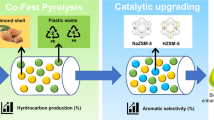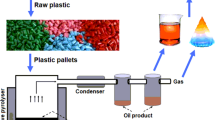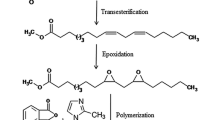Abstract
In this work, the direct liquefaction of polypropylene and rendering fat mixtures was performed by using light magnesium oxide (MgO) as catalyst. Polypropylene and rendering fat mixtures were tested in ratio of 10:0, 8:2, 6:4, 4:6, 2:8, and 0:10 (w/w) with 2 g of MgO and 50 g of tetralin as solvent and rendering fat:tetralin ratios of 10:50, 20:40, 30:30, 40:20, 50:10, and 60:10 w/w for the low temperature pyrolysis. Direct liquefaction was tested at 420 °C for 1 h, under nitrogen (1 MPa) in an autoclave. Furthermore, fast pyrolysis was performed to degrade these raw materials to light molecules such as ethylene and propylene. The raw materials and products were analyzed by a combination of several techniques: inductively coupled plasma thermal analyses, infrared spectroscopy, refractive index, elemental analyses (C, H, N, S%), and gas chromatography provided by a flame ionization detector (GC-FID), further analyzed by simulated distillation and refinery gas analysis (RGA).










Similar content being viewed by others
Abbreviations
- RF:
-
Rendering fat
- PP:
-
Polypropylene
References
Schmaltz E, Melvin EC, Diana Z, et al (2020) Plastic pollution solutions: emerging technologies to prevent and collect marine plastic pollution. Environ Int 144. https://doi.org/10.1016/j.envint.2020.106067
Abdel-Shafy HI, Mansour MSM (2018) Solid waste issue: sources, composition, disposal, recycling, and valorization. Egypt J Pet 27:1275–1290. https://doi.org/10.1016/j.ejpe.2018.07.003
Single-use plastics: New EU rules to reduce marine litter. European Commission - Fact Sheet. MEMO/18/3909. Brussels, 28 May (2018). Updated on 11/06/2018 at 11:40. Web page accessed on 7/30/2021: https://ec.europa.eu/commission/presscorner/detail/en/MEMO_18_3909
Martins LS, Silva NGS, Claro AM, et al (2021) Insight on açaí seed biomass economy and waste cooking oil: eco-sorbent castor oil-based. J Environ Manag 293. https://doi.org/10.1016/j.jenvman.2021.112803
Uz VE, Gökalp İ (2020) Sustainable recovery of waste vegetable cooking oil and aged bitumen: Optimized modification for short and long term aging cases. Waste Manage 110:1–9. https://doi.org/10.1016/j.wasman.2020.05.012
Rosson E, Sgarbossa P, Pedrielli F et al (2021) Bioliquids from raw waste animal fats: an alternative renewable energy source. Biomass Convers Biorefin 11:1475–1490. https://doi.org/10.1007/s13399-020-00634-z
Li J, Li W, Wang L, Jin B (2021) Environmental and cost impacts of food waste in university canteen from a life cycle perspective. Energies 14. https://doi.org/10.3390/en14185907
Fernandes F, Matos S, Gaspar D, et al (2021) Boosting the higher heating value of Eucalyptus globulus via thermochemical liquefaction. Sustainability 13. https://doi.org/10.3390/su13073717
Wang Y-Y, Chang C-C, Chang C-Y, et al (2016) Thermal cracking of Jatropha oil with hydrogen to produce bio-fuel oil. Energies 9. https://doi.org/10.3390/en9110910
Shen Y (2020) A review on hydrothermal carbonization of biomass and plastic wastes to energy products. Biomass Bioenergy 134. https://doi.org/10.1016/j.biombioe.2020.105479
Bezergianni S, Dimitriadis A, Kikhtyanin O, Kubička D (2018) Refinery co-processing of renewable feeds. Prog Energy Combust Sci 68:29–64. https://doi.org/10.1016/j.pecs.2018.04.002
Biswas S, Sharma DK (2012) Synergistic co-processing/co-cracking of Jatropha oil, petroleum vacuum residue, and high density polyethylene. J Renew Sustain Energy 4. https://doi.org/10.1063/1.4737924
Sugumaran V, Sugumaran V, Prakash S, Arora AK et al (2017) Thermal cracking of potato-peel powder-polypropylene biocomposite and characterization of products—Pyrolysed oils and bio-char. J Anal Appl Pyrol 126:405–414. https://doi.org/10.1016/j.jaap.2017.04.014
Behrendt F, Neubauer Y, Oevermann M et al (2008) Direct liquefaction of biomass. Chem Eng Technol 31:667–677. https://doi.org/10.1002/ceat.200800077
Pinto F, Paradela F, Costa P, Andre R, Rodrigues T, Snape C, Herrador JMH, Fratczak J (2018) The role of solvent and catalysts on co-liquefaction of coal and waste. Chem Eng Trans 70:1735–1740. https://doi.org/10.3303/CET1870290
Miandad R, Barakat MA, Aburiazaiza AS et al (2016) Catalytic pyrolysis of plastic waste: a review. Process Saf Environ Prot 102:822–838. https://doi.org/10.1016/j.psep.2016.06.022
Czajczyńska D, Anguilano L, Ghazal H et al (2017) Potential of pyrolysis processes in the waste management sector. Therm Sci Eng Prog 3:171–197. https://doi.org/10.1016/j.tsep.2017.06.003
Herink T, Belohlav Z, Zamostny P, Doskocil J (2006) Application of hydrocarbon cracking experiments to ethylene unit control and optimization. Pet Chem 46:237–245. https://doi.org/10.1134/S0965544106040037
Murat M, Gholami Z, Šimek J, et al (2021) Rendering fat and heavy Fischer-Tropsch waxes mixtures (0–100%) fast pyrolysis tests for the production of ethylene and propylene. Processes 9. https://doi.org/10.3390/pr9020367
Huo E, Lei H, Liu C, et al (2020) Jet fuel and hydrogen produced from waste plastics catalytic pyrolysis with activated carbon and MgO. Sci Total Environ 727. https://doi.org/10.1016/j.scitotenv.2020.138411
Zhang Y, Zhai X, Gao L et al (2017) Quality of wood-pressed rapeseed oil. J Am Oil Chem Soc 94:767–777. https://doi.org/10.1007/s11746-017-2986-y
Vlachos N, Skopelitis Y, Psaroudaki M et al (2006) Applications of Fourier transform-infrared spectroscopy to edible oils. Anal Chim Acta 573–574:459–465. https://doi.org/10.1016/j.aca.2006.05.034
Catauro M, Piccolella S, Leonelli C (2020) FT-IR Characterization of antimicrobial hybrid materials through sol-gel synthesis. Appl Sci 10. https://doi.org/10.3390/app10031180
Rafati A, Tahvildari K, Nozari M (2018) Production of biodiesel by electrolysis method from waste cooking oil using heterogeneous MgO-NaOH nano catalyst. Energy Sources A: Recovery Util Environ Eff 41:1062–1074. https://doi.org/10.1080/15567036.2018.1539139
Fang J, Zhang L, Sutton D et al (2012) Needleless melt-electrospinning of polypropylene nanofibres. J Nanomater 2012:1–9. https://doi.org/10.1155/2012/382639
Almazrouei M, Elagroudy S, Janajreh I (2019) Transesterification of waste cooking oil: quality assessment via thermogravimetric analysis. Energy Procedia 158:2070–2076. https://doi.org/10.1016/j.egypro.2019.01.478
Fabiani C, Pisello A, Barbanera M, et al (2019) Assessing the potentiality of animal fat based-bio phase change materials (PCM) for building applications: an innovative multipurpose thermal investigation. Energies 12. https://doi.org/10.3390/en12061111
Al-Maari MA, Ahmad MA, Din ATM, et al (2021) Co-pyrolysis of oil palm empty fruit bunch and oil palm frond with low-density polyethylene and polypropylene for bio-oil production. Arab J Chem 14. https://doi.org/10.1016/j.arabjc.2021.103282
Esmizadeh E, Tzoganakis C, Mekonnen TH (2020) Degradation behavior of polypropylene during reprocessing and its biocomposites: thermal and oxidative degradation kinetics. Polymers 12. https://doi.org/10.3390/polym12081627
Vohlídal J (2021) Polymer degradation: a short review. Chemistry Teacher International 3:213–220. https://doi.org/10.1515/cti-2020-0015
Zhao Y, Wang W, Jing X, et al (2020) Catalytic cracking of polypropylene by using Fe-SBA-15 synthesized in an acid-free medium for production of light hydrocarbon oils. J Anal Appl Pyrolysis 146. https://doi.org/10.1016/j.jaap.2019.104755
Ouchi T, Yamazaki M, Maeda T, Hotta A (2021) Mechanical property of polypropylene gels associated with that of molten polypropylenes. Gels 7. https://doi.org/10.3390/gels7030099
Xing H, Wan D, Qiu J et al (2014) Combined effects between activating group Z and leaving group R in dithiocarbamates for controlling degradation and branching reactions of polypropylene. Polymer 55:5435–5444. https://doi.org/10.1016/j.polymer.2014.09.005
Nikaido S, Suenobu T, Nakagawa T, Katoh R (2019) Delocalization of positive charge in aromatic liquids studied by subnanosecond near-infrared transient absorption spectroscopy. Chem Phys Lett 731. https://doi.org/10.1016/j.cplett.2019.07.006
Huerta-Angeles G, Brandejsová M, Kulhánek J et al (2016) Linolenic acid grafted hyaluronan: process development, structural characterization, biological assessing, and stability studies. Carbohyd Polym 152:815–824. https://doi.org/10.1016/j.carbpol.2016.07.030
Omidghane M, Bartoli M, Asomaning J et al (2020) Pyrolysis of fatty acids derived from hydrolysis of brown grease with biosolids. Environ Sci Pollut Res 27:26395–26405. https://doi.org/10.1007/s11356-020-09041-3
Yarranton HW, Okafor JC, Ortiz DP, van den Berg FGA (2015) Density and refractive index of petroleum, cuts, and mixtures. Energy Fuels 29:5723–5736. https://doi.org/10.1021/acs.energyfuels.5b01376
Hidalgo-Herrador JM, Frątczak J, Velvarská R, de Paz Carmona H (2020) Oxalic acid-mediated catalytic transfer hydrodeoxygenation of waste cooking oil. Mol Catal 491. https://doi.org/10.1016/j.mcat.2020.110973
Schwach P, Hamilton N, Eichelbaum M et al (2015) Structure sensitivity of the oxidative activation of methane over MgO model catalysts: II. Nature of active sites and reaction mechanism. J Catal 329:574–587. https://doi.org/10.1016/j.jcat.2015.05.008
Maher KD, Bressler DC (2007) Pyrolysis of triglyceride materials for the production of renewable fuels and chemicals. Biores Technol 98:2351–2368. https://doi.org/10.1016/j.biortech.2006.10.025
Acknowledgements
This publication is a result of the project CACTU, Reg. No. CZ.02.1.01/0.0/0.0/17_049/0008397, which has been co-financed by the European Union from the European Regional Development Fund through the Operational Programme Research, Development and Education. The result was achieved using the infrastructure of the project Efficient Use of Energy Resources Using Catalytic Processes (LM2018119) which has been financially supported by MEYS within the targeted support of large infrastructures.
Funding
1) Funder: Ministerstvo Školství, Mládeže a Tělovýchovy. Award number: CZ.02.1.01/0.0/0.0/17_049/0008397. 2) Funder: Ministerstvo Školství, Mládeže a Tělovýchovy (Grant number: LM2018119.
Author information
Authors and Affiliations
Contributions
All authors contributed to the study conception and design. Material preparation, data collection, and analysis were performed by José Miguel Hidalgo Herrador, Martin Babor, Ritik Tomar, and Zdeněk Tišler. The manuscript was written by José Miguel Hidalgo Herrador and contributions of all authors. All authors read and approved the final manuscript.
Corresponding author
Ethics declarations
Conflict of interest
The authors declare no competing interests.
Human and animal rights and informed consent
No animals or humans were used for this research work.
Additional information
Publisher's note
Springer Nature remains neutral with regard to jurisdictional claims in published maps and institutional affiliations.
Rights and permissions
About this article
Cite this article
Hidalgo Herrador, J.M., Babor, M., Tomar, R. et al. Polypropylene and rendering fat degrading to value-added chemicals by direct liquefaction and fast-pyrolysis. Biomass Conv. Bioref. 14, 1027–1036 (2024). https://doi.org/10.1007/s13399-022-02405-4
Received:
Revised:
Accepted:
Published:
Issue Date:
DOI: https://doi.org/10.1007/s13399-022-02405-4




